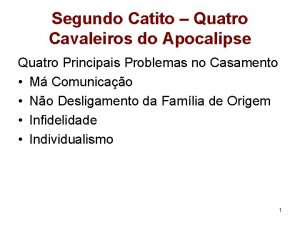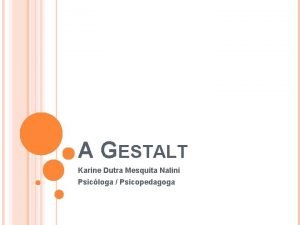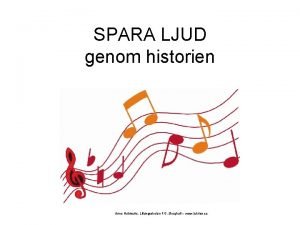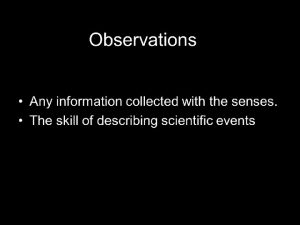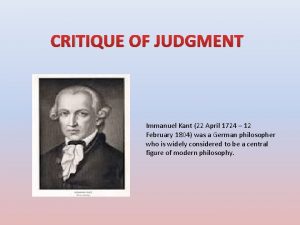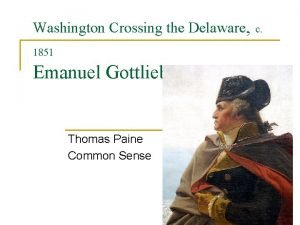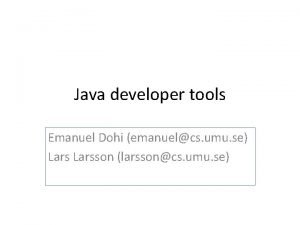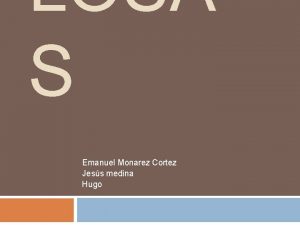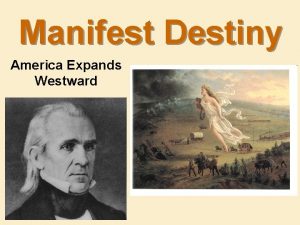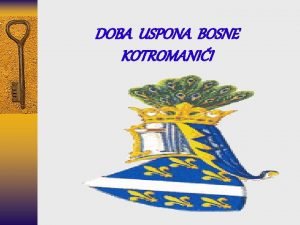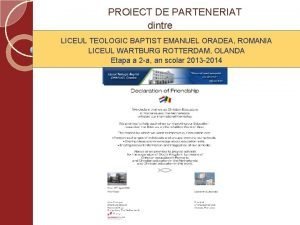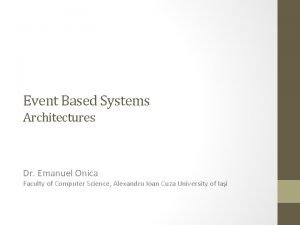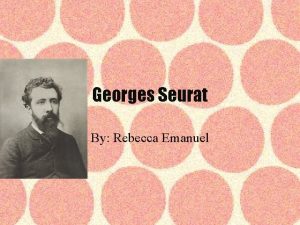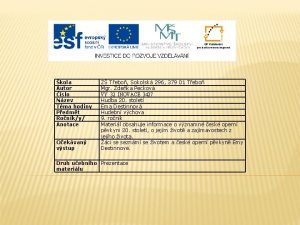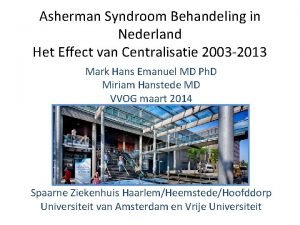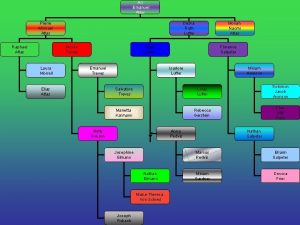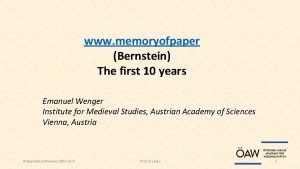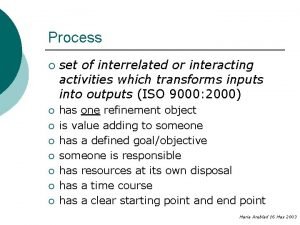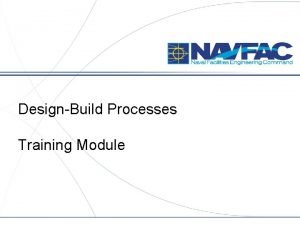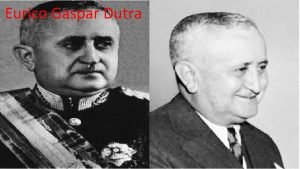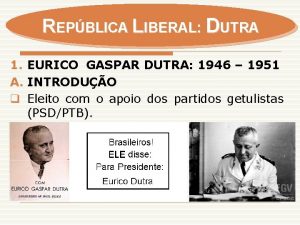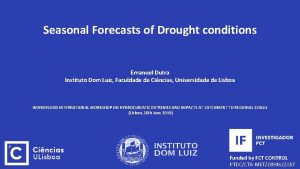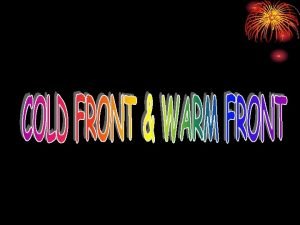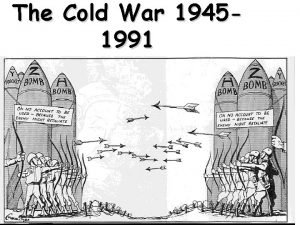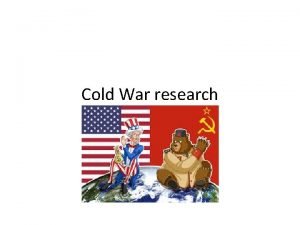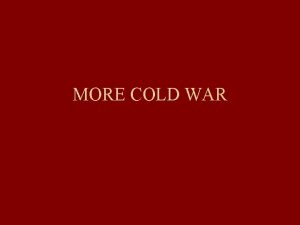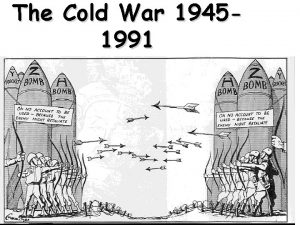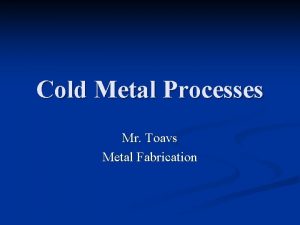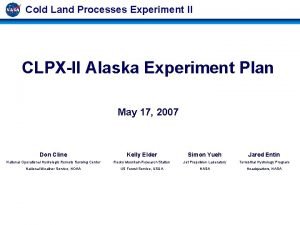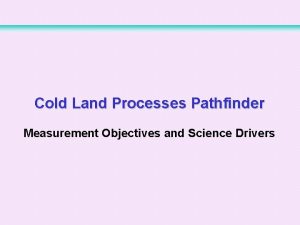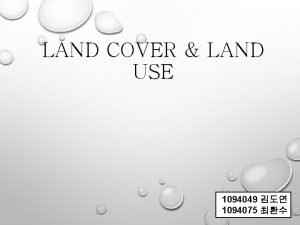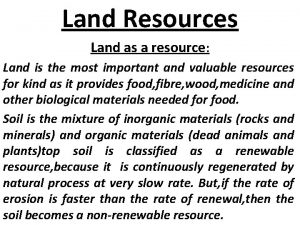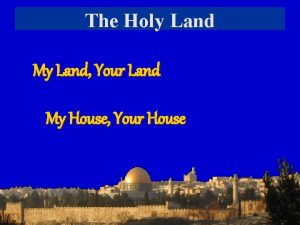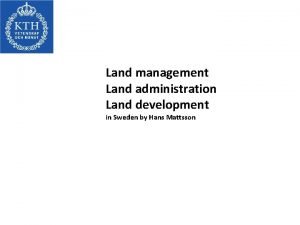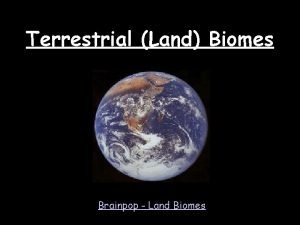Land Surface2 Cold processes Snowsoil Emanuel Dutra emanuel



































- Slides: 35

Land Surface(2) Cold processes: Snow/soil Emanuel Dutra emanuel. dutra@ecmwf. int PA Surface II of III – Training course 2016 Slide 1

Layout of these lectures Introduction General remarks Model development and validation Cold processes: Snow & soil Snow atmosphere coupling Earth Energy budget Lecture 1 Lecture 2 Lecture 3 Soil/Water/Vegetation Contrasts PA Surface II of III – Training course 2016 Slide 2

Outline Ø Snow in the climate system, an overview: Ø Observations; Ø Modeling; Ø Forecasts impact. Ø Snow representation in the ECMWF model: Ø Energy/Water balance; Ø Density/ Albedo / Snow cover fraction; Ø Evaluation examples. Ø Soil heat & water in frozen conditions Ø Soil heat transfer and phase changes Ø Soil water in frozen conditions Ø Ongoing & future work. PA Surface II of III – Training course 2016 Slide 3

Snow in the climate system Snow cover is the seconds largest component of the Cryosphere (after seasonally frozen ground) with a mean maximum areal extend of 47 million km 2 (98% in the Northern Hemisphere, and 1/3 of the total land ); Several fundamental physical properties of snow modulate the energy/water exchanges between the surface and the atmosphere: • Surface reflectance: • – Albedo, snow-albedo feedback. Thermal properties: • – Effective de-coupling heat and moisture transfers. Phase changes: – – Delayed warming during the melt period. Implications for all forecasts ranges (medium to seasonal). – Predictability impact. – Climate change impacts. (see Armstrong and Brun (2008 ) for a good reference of snow and climate) PA Surface II of III – Training course 2016 Slide 4

Snow cover and NH variability - observations • • • In addition to cover a substantial part of the Northern hemisphere, Large inter-annual variability In particular during the accumulation period (e. g. Mid October) This has been widely studied as potential source of long-range predictability Can these anomalies in snow-cover in October influence Winter circulation ? Other teleconnections: • Snow cover in Eurasia and Indian summer monsoon: questionable (see Peings and Douville 2010) (Gong et al. 2007) PA Surface II of III – Training course 2016 Slide 5

Snow cover and NH variability - observations October snow cover anomalies correlated with Winter (DJF) surface temperature Winter (DJF) sea level pressure (Gong et al. 2007, Cohen and Saito 2003) • • The spatial anomaly patterns resemble the Artic Oscillation pattern of variability This allows the development of statistical prediction models for winter variability based on early Autumn snow cover that beat current dynamical seasonal forecast systems (why… ? ) PA Surface II of III – Training course 2016 Slide 6

Trends and climate change implications • • Snow cover extent in the N. H land: • Red satellite data • Black CMIP 5 mean Normalized by maximum extend in each month • April/May observed trends are within the CMIP 5 range# • June observed trend is very large in the last years and not captured by any model (models only get there around 2050 ! ) • What are the models (we) missing? (Derksen and Brown 2012) PA Surface II of III – Training course 2016 Slide 7

Snow initialization and sub-seasonal forecasts • Changes in potential predictability r 2 between initializing snow depth or not • General increase of about 10% in particular during the first month. • In this study the signal in actual predictability is smaller, but there is still some signal. . Jeong et al. 2012 PA Surface II of III – Training course 2016 Slide 8

Case study: Boreal forest albedo 1997 Operational Bias (FAL) 1996 Operational Bias (CON) ● The surface albedo is the direct regulator of the energy available to the surface. The albedo of natural surfaces has a limited range (0. 1 -0. 3), but in nonforested snow covered areas can reach values up to 0. 8. ● Snow covered boreal forests have a much lower albedo than grassland to their south and tundra to their north; the presence of boreal forests has a direct control on the climate of highlatitudes. Viterbo and Betts 1999 PA Surface II of III – Training course 2016 Slide 9

Case study: Boreal forest albedo 850 h. Pa temperature bias 20 forecasts every 3 days, March-April 1996 No data assimilation Northern Hemisphere Eastern Asia 0 0 FAL -1 -1 -2 CON -3 0 Forecast day 10 0 Forecast day Considering a lower value of snow Forest ALbedo was beneficial. PA Surface II of III – Training course 2016 Slide 10 10

Outline Ø Snow in the climate system, an overview: Ø Observations; Ø Modeling; Ø Forecasts impact. Ø Snow representation in the ECMWF model: Ø Energy/Water balance; Ø Density/ Albedo / Snow cover fraction; Ø Evaluation examples. Ø Soil heat & water in frozen conditions Ø Soil heat transfer and phase changes Ø Soil water in frozen conditions Ø Ongoing & future work. PA Surface II of III – Training course 2016 Slide 11

Snow in HTESSEL Two tiles: 1) Exposed snow; 2) Snow under high vegetation Single snow-pack evolution Prognostic evolution: 1)Snow mass 2)Snow density 3) Snow temperature 4) Snow Albedo Diagnostics: 1) Snow depth 2) Snow cover fraction 3) Liquid water content See Dutra et al. 2010 for more details PA Surface II of III – Training course 2016 Slide 12

Snow in HTESSEL – energy balance Net radiation Latent Heat capacity Sensible Snow depth Heat capacity barrier Diagnostic liquid water Internal freezing/melting Snow liquid water capacity PA Surface II of III – Training course 2016 Slide 13 Basal Melting

Snow in HTESSEL – water balance Snow mass Rainfall Snow runoff Sublimation Snowfall • Rainfall and Sublimation only over the snow cover fraction • Rainfall is considered to reach the snow at freezing point • Runoff is the rate at which liquid water leaves the snowpack • Runoff is generated when the liquid water content exceeds the snow liquid water capacity Before 2009 liquid water was not considered PA Surface II of III – Training course 2016 Slide 14

Snow in HTESSEL – density • 1 st term: overburden – increase density due to the snow weight • 2 nd term: thermal metamorphism: snow crystal destruction with time as function of temperature and density • 3 rd term: Increased density due to re-freezing • • Snow density update after snowfall; Snowfall density as a function of Wind speed, and air temperature Snow density formulation before 2009 PA Surface II of III – Training course 2016 Slide 15

Snow in HTESSEL – snow albedo • • • Linear decay in normal conditions; Exponential decay in melting condictions; Min/Max albedos of 0. 5 and 0. 85. • Reset snow albedo after snowfall : requires 10 kg m 2 to reset to maximum • • PA Surface II of III – Training course 2016 For snow under high vegetation we keep the albedo constant (derived from Satellite data) Neglect seasonal variations Slide 16

Snow in HTESSEL – snow cover fraction Snow cover fraction as a function of snow depth • • • Affects the tile fraction : direct albedo effect Energy balance indirectly Actual snow depth: We have a depth “barrier” at 10 cm Pile the snow as snow mass / snow-cover fraction reduces PA Surface II of III – Training course 2016 Slide 17

Outline Ø Snow in the climate system, an overview: Ø Observations; Ø Modeling; Ø Forecasts impact. Ø Snow representation in the ECMWF model: Ø Energy/Water balance; Ø Density/ Albedo / Snow cover fraction; Ø Evaluation examples. Ø Soil heat & water in frozen conditions Ø Soil heat transfer and phase changes Ø Soil water in frozen conditions Ø Ongoing & future work. PA Surface II of III – Training course 2016 Slide 18

Point evaluation Point simulations (offline) in a forest and open areas nearby CTR (gray) : model before 2009 NEW (black) : current model • • PA Surface II of III – Training course 2016 Better simulations of snow mass - Albedo changes - Liquid water representation Improved snow density • Before – exponential increase • Snow follows closely observations. Still some problems during melting Slide 19

Basin scale evaluation Regional offline simulations over the Ob (Siberia basin) PA Surface II of III – Training course 2016 - Increase in snow mass - Interception of rainfall - Lower densities during accumulation/winter seasons - Reduction of soil freezing Increase of surface runoff Decrease of bottom drainage Improvement of total runoff - Lower densities -> less coupling -> less soil freezing -> less surface runfoff Slide 20

Warm temperature bias over Antarctica ●Several studies reported a warm bias of surface & T 2 m during the polar night over Antarctica: – Difficulties representing strong radiative cooling events (skin and T 2 m); – Can it be associated with the surface turbulent fluxes under very stable conditions ? – Land-atmosphere coupling (surface thermal inertia) ? Fréville et al. 2014 Skin temperature vs MODIS Mitchell & Jone 2005 T 2 m ERAI vs Had. CRUT 4 PA Surface II of III – Training course 2016 Slide 21

Surface and snow energy balance (1) S Net longwave H=Sensible heat S= Surface heat - Polar night: no shortwave and latent heat is very small G (2) Glaciers are represented with 30 m snow with 1 m thermally active (Dsn=1 m) 1 meter snow has a large thermal inertia and ground heat flux (G) is unrealistic: – DSN: in (2) we reduce thermally active layer to 10 cm and neglect G (proxy for snow muti-layer); Surface heat flux is small during radiative cooling events (Tsk ≈ Tsn ): – COND: in (1) skin conductivity changed from 7 to a very small value; Sensible heat flux – transfer coefficient (CH) : – ROU : Reduce momentum roughness from 1. 3 x 10 -3 to 1 x 10 -4 and heat from 1. 3 x 10 -4 to 5 x 10 -5; – EXC: Different formulation of the transfer coefficient CH as used in SURFEX (from Holtslag and De Bruin (1988) to Louis (1979)). PA Surface II of III – Training course 2016 Slide 22 22

South Pole surface-only simulations (1) We start by running the ECMWF land surface model (HTESSEL) in stand-alone mode forced by the atmospheric conditions of ERA-Interim (similar to what Fréville et al. 2014 did with CROCUS). MODIS CROCUS ERAI CTR ROU EXC South Pole station : comparing with BSRN, MODIS, CROCUS with our simulations: DSN (or COND) are necessary to remove the “tail” in cold situations, i. e. need a fast thermal response at the surface; Decreasing the roughness (ROU) or the DSN different formulation of the transfer coefficients (EXC) act on the systematic bias; DSN_ROU_EXC PA Surface II of III – Training course 2016 Slide 23 DSN_ROU DSN_EXC Scatter plots of simulated skin temperature vs. BSRN during August 2009 23

Forecasts with the coupled system Current model version with T 255 (about 0. 7°) and 137 vertical levels: short-range forecasts initialized every day at 00 UT for August 2009 using ERA-Interim. Monthly mean computed with forecast steps +12/18/24/30 h Skin temperature • Reduction of thermally active snow layer (DSN) reduces skin temperature, but restricted to mainly clear sky regions; • Roughness reduction: general decrease of temperature but increased wind speed: impact in coupled mode damped compared with stand-alone DSN-CTR DSN_ROU-DSN Wind speed (lowest model level Cloud cover DSN-CTR PA Surface II of III – Training course 2016 DSN_ROU-CTR DSN_ROU-DSN Slide 24 24

Outline Ø Snow in the climate system, an overview: Ø Observations; Ø Modeling; Ø Forecasts impact. Ø Snow representation in the ECMWF model: Ø Energy/Water balance; Ø Density/ Albedo / Snow cover fraction; Ø Evaluation examples. Ø Soil heat & water in frozen conditions Ø Soil heat transfer and phase changes Ø Soil water in frozen conditions Ø Ongoing & future work. PA Surface II of III – Training course 2016 Slide 25

HTESSEL heat transfer ● Solution of heat transfer equation with the soil discretized in 4 layers, depths 7, 21, 72, and 189 cm. ● No-flux bottom boundary condition ● Heat conductivity dependent on soil water ● Thermal effects of soil water phase change ↓ 0. 1~0. 6 d ↓ 1. 1~5. 8 d ↓ 10. 6 ~ 55. 8 d PA Surface II of III – Training course 2016 Time-scale for downward heat transfers in wet/dry soil Slide 26

Winter: Soil water freezing Soil heat transfer equation in soil freezing condition Apparent heat capacity PA Surface II of III – Training course 2016 Slide 27

Case study: winter (1) Model vs observations, Cabauw, The Netherlands, 2 nd half of November 1994 140 m 2 m Soil PA Surface II of III – Training course 2016 Slide 28

Case study: winter (2) Soil Temperature, North Germany, Feb 1996: Model (28 -100 cm) vs OBS 50 cm Observations: Numbers Model: Contour PA Surface II of III – Training course 2016 Slide 29

Case study: winter (3) Germany soil temperature: Observations vs Long model relaxation integrations Observations Stab+Freezing Stability Control 1 Oct PA Surface II of III – Training course 2016 1 Nov 1 Jan Slide 30 1 Feb

HTESSEL soil water equations Volumetric soil water transfer equation Sink term (root extraction) Darcy’s Law ↓ 0. 1~19. 7 d ↓ 1. 2~195. 9 d Hydraulic diffusivity conductivity ) ↓ 11. 7 ~ >> d The half levels (layer interface) diffusivity & conductivity Fraction of soil frozen Wilting point : almost now water movement Time-scale for downward water transfers in wet/dry soil PA Surface II of III – Training course 2016 Slide 31

HTESSEL soil water/snow/runoff Runoff / precipitation Simulation of runoff in a northern catchment: Early runoff peak: • Early snow melt ? Soil Temperature • Too much soil frozen ? • Water movement in freezing conditions? Soil moisture / SWE PA Surface II of III – Training course 2016 Slide 32

HTESSEL soil water/snow/runoff Runoff / precipitation Simulation of runoff in a northern catchment: Early runoff peak: • Early snow melt ? Soil Temperature • Too much soil frozen ? • Water movement in freezing conditions? Yes & No Soil moisture / SWE • Under-estimation of snow accumulation • Early snow & soil melting • Large uncertainty in Snowfall observations, but data assimilation can correct snow depth. PA Surface II of III – Training course 2016 Slide 33

Neglected processes Rain on snow – Rainfall is assumed to fall at freezing point : No heat flux advection – Rainfall interception partially treated but would require a prognostic liquid water reservoir for a proper evolution; Blowing snow – No snow mass displacement (reasonable at the resolutions we ran the model ); – Neglect the effects of blowing snow sublimation (estimates of about +/- 5 kg m 2 during a winter season over Siberia (Brun et. al 2012); Snowfall interception by vegetation: – Changes albedo, different sublimation rates; Vertical structure of snowpack – Single layer cannot represent the vertical structure (memory); Thermal implications; Snow on top of Glaciers / Sea-ice – Glaciers set to 10 meters of snow ! And no snow on top of sea-ice. Soil Freezing – Once the soil is frozen there is no infiltration (sub-grid scale variability ? Preferential flow? ) PA Surface II of III – Training course 2016 Slide 34

Further Reading Armstrong, R. L. , and Brun, E. , 2008: Snow and Climate. Physical processes, surface energy exchange and modeling. Cambridge University press, 222 pp. Brun, E. , V. Vionnet, et al. (2012). "Simulation of Northern Eurasian Local Snow Depth, Mass, and Density Using a Detailed Snowpack Model and Meteorological Reanalyses. " Journal of Hydrometeorology 14(1): 203 -219. Cohen, J. and J. Jones (2011). "A new index for more accurate winter predictions. " Geophysical Research Letters 38(21): L 21701. Derksen, C. and R. Brown (2012). "Spring snow cover extent reductions in the 2008– 2012 period exceeding climate model projections. " Geophysical Research Letters 39(19): L 19504. Dutra, E. , G. Balsamo, et al. (2010). "An Improved Snow Scheme for the ECMWF Land Surface Model: Description and Offline Validation. " Journal of Hydrometeorology 11(4): 899 -916. Dutra, E. , S. Kotlarski, et al. (2011). "Snow cover sensitivity to horizontal resolution, parameterizations, and atmospheric forcing in a land surface model. " Journal of Geophysical Research-Earth Surface 116(D 21): D 21109. Dutra, E. , P. Viterbo, et al. (2012). "Complexity of Snow Schemes in a Climate Model and Its Impact on Surface Energy and Hydrology. " Journal of Hydrometeorology 13(2): 521 -538. Dutra, E. , I. Sandu, G. Balsamo, A. Beljaars, H. Freville, E. Vignon and E. Brun (2015). "Understanding the ECMWF winter surface temperature biases over Antarctica. " ECMWF Tech. Memo. 762: 16 pp. Fréville, H. , et al. (2014). "Using MODIS land surface temperatures and the Crocus snow model to understand the warm bias of ERA-Interim reanalyses at the surface in Antarctica. " The Cryosphere 8(4): 1361 -1373. Gong, G. , J. Cohen, et al. (2007). "Hemispheric-scale climate response to Northern Eurasia land surface characteristics and snow anomalies. " Global and Planetary Change 56(3 -4): 359 -370. Jeong, J. -H. , H. W. Linderholm, et al. (2012). "Impacts of Snow Initialization on Subseasonal Forecasts of Surface Air Temperature for the Cold Season. " Journal of Climate 26(6): 1956 -1972. Orsolini, Y. J. , R. Senan, et al. (2013). "Impact of snow initialization on sub-seasonal forecasts. " Climate Dynamics 41(7 -8): 1969 -1982. Peings, Y. and H. Douville (2010). "Influence of the Eurasian snow cover on the Indian summer monsoon variability in observed climatologies and CMIP 3 simulations. " Climate Dynamics 34(5): 643 -660. Viterbo, P. , A. Beljaars, J. F. Mahfouf and J. Teixeira (1999). "The representation of soil moisture freezing and its impact on the stable boundary layer. " Quarterly Journal of the Royal Meteorological Society 125(559): 2401 -2426. Viterbo, P. and A. K. Betts (1999). "Impact on ECMWF forecasts of changes to the albedo of the boreal forests in the presence of snow. " Journal of Geophysical Research-Atmospheres 104(D 22): 27803 -27810. PA Surface II of III – Training course 2016 Slide 35
 Haroldo dutra dias divorciado
Haroldo dutra dias divorciado Karine dutra
Karine dutra Karine dutra
Karine dutra Haroldo dutra apocalipse
Haroldo dutra apocalipse Concurrent processes are processes that
Concurrent processes are processes that Cold working vs hot working
Cold working vs hot working Lesson 1 the cold war begins
Lesson 1 the cold war begins What are landforms
What are landforms High rocky land usually with steep sides
High rocky land usually with steep sides Elektro emanuel
Elektro emanuel Emanuel timoni
Emanuel timoni Carl wilhelm scheele forensics
Carl wilhelm scheele forensics Michelle d'arcy tcd
Michelle d'arcy tcd Emanuel kanti
Emanuel kanti Emanuel leutze
Emanuel leutze Emanuel dohi
Emanuel dohi Doctor hugo castro medina
Doctor hugo castro medina Emanuel leutze westward the course of empire
Emanuel leutze westward the course of empire Stjepan 2 kotromanic
Stjepan 2 kotromanic Liceul teologic baptist emanuel
Liceul teologic baptist emanuel Emanuel lehman
Emanuel lehman Emanuel onica
Emanuel onica Rebekah emanuel
Rebekah emanuel Emanuel kittl
Emanuel kittl Egg för emanuel
Egg för emanuel Dileme etice in cercetare
Dileme etice in cercetare Emanuel wüthrich
Emanuel wüthrich Ziekte van asherman
Ziekte van asherman Emanuel pacheco
Emanuel pacheco Rebecca gerstein
Rebecca gerstein Bernstein memory of paper
Bernstein memory of paper Interrelated processes
Interrelated processes What is cellular respiration equation
What is cellular respiration equation Reading processes
Reading processes The process consists of
The process consists of Navfac bms processes
Navfac bms processes
